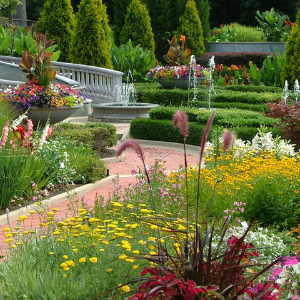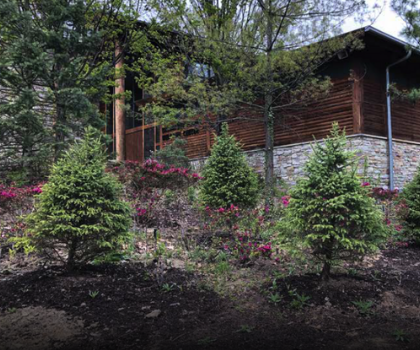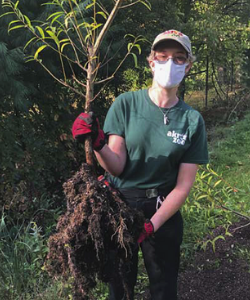I’ve worked in the Akron Zoo’s Horticulture Department for a year and a half now, and zoo horticulture is definitely struggling because of COVID-19. However, we’re adapting and innovating to make up for that.
 Over the course of 2020, our small team has employed a barrage of tactics to keep the zoo looking both spiffy and botanically-relevant. We’ve rehomed plants from nearby zoo-owned lots, started plants from seed, been vigilant about saving bulbs and tubers, and even received many monetary and plant donations. We’re also taking full advantage of our on-site composter, "Big Hanna.”
Over the course of 2020, our small team has employed a barrage of tactics to keep the zoo looking both spiffy and botanically-relevant. We’ve rehomed plants from nearby zoo-owned lots, started plants from seed, been vigilant about saving bulbs and tubers, and even received many monetary and plant donations. We’re also taking full advantage of our on-site composter, "Big Hanna.”
Horticulture for private estates, arboretums, and botanical gardens is certainly still important since people need a green oasis now more than ever, but zoo horticulture is a whole different beast. Our goal is not just to provide beautiful plants for guests to view, but to feed and stimulate the many animals in our care.
Thus enters the concept of browse, which is an interesting—and some might even say, controversial—point of discussion at the zoo. In theory, browse is simple. Someone collects a botanical object and gives it to an animal. The animal eats or plays with this object and gets nutrition and/or cranial stimulation from it. Theoretically, our keepers should be able to just go out and collect branches, grasses, leaves and flowers from the surrounding landscaping without problem, right? The issue is that the landscaping closest to an animal habitat is usually used for its aesthetic value. It either adds directly to the beauty of the space, or it provides screening, so that the public can’t see something that would disrupt their viewing experience. To prune a branch that provides beauty or screening is a big no-no.
It is our hope that someday keepers will be able to plant browse near animal habitats and use it for the benefit of the animals, even if it may detract somewhat from the beauty of the park. In the meantime, we are finding specific areas of the property to place new browse plants or sustainably harvest mature specimens. Additionally, we’ve got a list of invasive plants found readily throughout the zoo that provide very little horticultural benefit. These plants could be completely removed by keepers to be used for browse, and we horticulturalists wouldn’t mind one bit. In fact, keepers would be doing us a favor while also supporting the zoo’s message of conservation, to boot. After all, animal and plant conservation are intertwined, and invasive species can have a negative impact on native plants and animals.
 Unfortunately, because the zoo is constantly growing, it’s hard to know where new projects will extend geographically, so it’s nearly impossible to find a permanent location for a browse garden. Prior to COVID-19, we were planning to create a browse garden in a centrally-located area that wouldn’t be touched by construction for at least 10+ years. We hoped to employ the concept of coppicing, where trees grow for years until their root systems are well-developed, then are cut to the ground. This way they can flush out multitudes of new branches once or twice a year. However, as things have developed and construction plans changed, we set our sights on “The Back 40” instead. This large tract of land isn’t actually 40 acres, and it might not even be around for many more years, but while we’ve got it, we’re working in conjunction with keepers to turn part of this undeveloped land into a sustainable browse operation.
Unfortunately, because the zoo is constantly growing, it’s hard to know where new projects will extend geographically, so it’s nearly impossible to find a permanent location for a browse garden. Prior to COVID-19, we were planning to create a browse garden in a centrally-located area that wouldn’t be touched by construction for at least 10+ years. We hoped to employ the concept of coppicing, where trees grow for years until their root systems are well-developed, then are cut to the ground. This way they can flush out multitudes of new branches once or twice a year. However, as things have developed and construction plans changed, we set our sights on “The Back 40” instead. This large tract of land isn’t actually 40 acres, and it might not even be around for many more years, but while we’ve got it, we’re working in conjunction with keepers to turn part of this undeveloped land into a sustainable browse operation.
This project is still very much a work in progress. So far, the plan has been to plant browse using a grid system, where metal stakes will turn the tract into a number of plots. Each plot will be the same size and include a decent variety of plants suitable for browse. A different plot will be “available” for harvesting by specific keepers each day, and no more than 10% of each plant species can be harvested at once. Keepers will be responsible for collecting browse, while horticulture specialists will designate which plants can be harvested and which plants still need time to recover.
 In order for this operation to be sustainable, not only do we need to maintain current growth, but as time passes we will also need to add new plants into the equation. Some plants, such as willows, red twig dogwoods, and forsythia, are ideally suited for this task since it’s possible to just stick a cutting into potting soil and let them grow. After a period they’ll root, and then those new saplings can be planted out.
In order for this operation to be sustainable, not only do we need to maintain current growth, but as time passes we will also need to add new plants into the equation. Some plants, such as willows, red twig dogwoods, and forsythia, are ideally suited for this task since it’s possible to just stick a cutting into potting soil and let them grow. After a period they’ll root, and then those new saplings can be planted out.
I did start a “willow amphitheater” with about two dozen willow plants in one of the bio-retention basins at the back of our parking lot. I grew the willows from cuttings I took last winter. In time, these plants will grow dense, and they’ll be even easier to access than the browse plants in the Back 40. Of course, there’s a limit on how much willow any one animal can eat in a short period of time, but it’s a start, and maybe one day it can have a sign and become a demonstration garden for the public.
With our powers united, a grassroots browse campaign supported by both horticulture and animal care exemplifies adaptability. Of course, the animals are the benefactors of this combined effort and that’s what it’s really all about.
